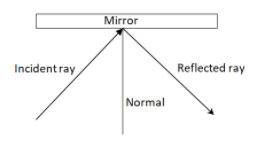
Describe an activity to show that the incident ray, the reflected ray, and the normal at the point of incidence lie in the same plane.
Answer
407.1k+ views
Hint: The main factor while choosing the activity is to prove that incident ray, reflected ray, and normal lie on the same plane. A clear understanding of the incident ray reflected ray and the properties of reflection will enable one to deduce an activity for this rule. When light is incident on a mirror or a reflective surface the light will bounce or reflect into the same medium.
Complete step-by-step solution:
Apparatus: Drawing board, Sheet of paper, laser light, plane mirror.
Procedure:
Place a sheet of paper on the drawing board. Place a plane mirror on the piece of paper and draw an outline of the mirror. Also, draw a normal to the mirror.
Now shine the laser light at an angle to the mirror such that it falls on the normal at the bottom of the mirror. If shined normal to the mirror, no incidence or reflected ray will be observed as the angle of incidence, in this case, is zero, thereby the angle of reflection is also zero.
When the laser light is incident on the mirror, it gets reflected at an angle to the normal.
We can easily observe that the incident ray, the reflected ray, and the normal at the point of incidence all lie in the same plane.
From this activity, it is observed that the normal, the line of incidence, and the reflected ray all lie on the same plane.

Note: This activity can also be used to determine that the angle of incidence is equal to the angle of reflection. Care must be taken while handling laser light. Do not point the laser source to your eyes as it can cause permanent damage. In the case of reflection another imperative property is that the angle of incidence is always equal to the angle of reflection.
Complete step-by-step solution:
Apparatus: Drawing board, Sheet of paper, laser light, plane mirror.
Procedure:
Place a sheet of paper on the drawing board. Place a plane mirror on the piece of paper and draw an outline of the mirror. Also, draw a normal to the mirror.
Now shine the laser light at an angle to the mirror such that it falls on the normal at the bottom of the mirror. If shined normal to the mirror, no incidence or reflected ray will be observed as the angle of incidence, in this case, is zero, thereby the angle of reflection is also zero.
When the laser light is incident on the mirror, it gets reflected at an angle to the normal.
We can easily observe that the incident ray, the reflected ray, and the normal at the point of incidence all lie in the same plane.
From this activity, it is observed that the normal, the line of incidence, and the reflected ray all lie on the same plane.

Note: This activity can also be used to determine that the angle of incidence is equal to the angle of reflection. Care must be taken while handling laser light. Do not point the laser source to your eyes as it can cause permanent damage. In the case of reflection another imperative property is that the angle of incidence is always equal to the angle of reflection.
Recently Updated Pages
Master Class 11 Accountancy: Engaging Questions & Answers for Success

Express the following as a fraction and simplify a class 7 maths CBSE

The length and width of a rectangle are in ratio of class 7 maths CBSE

The ratio of the income to the expenditure of a family class 7 maths CBSE

How do you write 025 million in scientific notatio class 7 maths CBSE

How do you convert 295 meters per second to kilometers class 7 maths CBSE

Trending doubts
When people say No pun intended what does that mea class 8 english CBSE

In Indian rupees 1 trillion is equal to how many c class 8 maths CBSE

How many ounces are in 500 mL class 8 maths CBSE

Which king started the organization of the Kumbh fair class 8 social science CBSE

What is BLO What is the full form of BLO class 8 social science CBSE

Advantages and disadvantages of science




